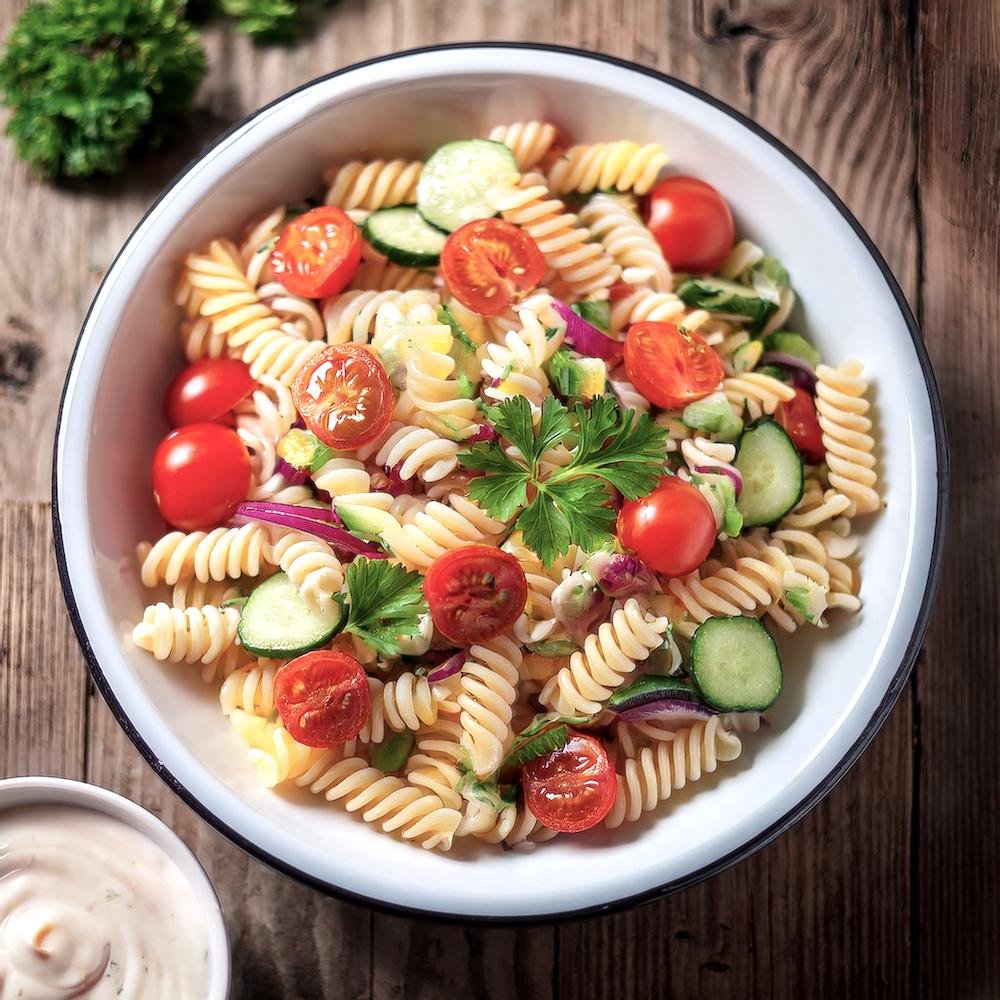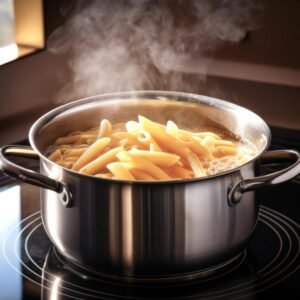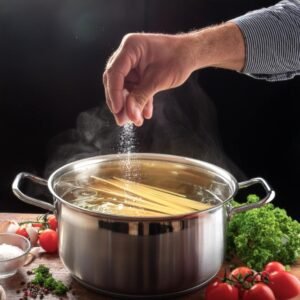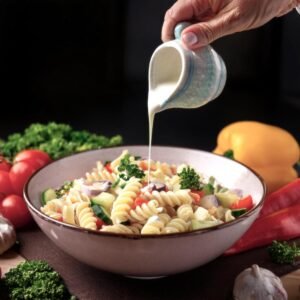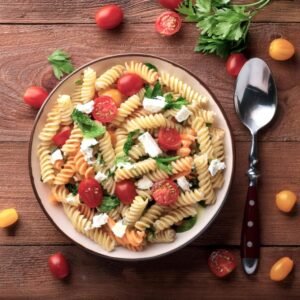What are the five mistakes to avoid pasta salad? This versatile and popular dish is perfect for potlucks, picnics, and weeknight dinners. With endless combinations of pasta shapes, fresh vegetables, proteins, and dressings, pasta salad remains a favorite for both cooks and guests. However, as simple as it seems, a few common missteps can ruin its flavor, texture, or appeal.
Whether you’re a seasoned chef or a home cook, understanding what are the five mistakes to avoid pasta salad will help you consistently create a delicious, fresh, and well-balanced dish. In this article, we’ll explore these pitfalls and share tips to perfect your pasta salad every time.
Mistake 1: Overcooking or Undercooking the Pasta
The pasta is the foundation of any pasta salad, so its texture can make or break the dish. Overcooked pasta turns mushy and clumps together, while undercooked pasta is too firm and unappetizing.
Why It Matters
- Overcooked pasta absorbs too much dressing, becoming soggy and heavy.
- Undercooked pasta doesn’t blend well with other ingredients and can feel chewy or dry.
How to Get It Right
- Cook Pasta Al Dente
- Follow the package instructions for al dente pasta, which means “to the tooth” in Italian. This ensures the pasta retains a slight firmness while being fully cooked.
- Taste-Test the Pasta
- Check the pasta 1–2 minutes before the suggested cooking time to ensure it’s not overdone.
- Rinse with Cold Water
- After draining, rinse the pasta under cold water to stop the cooking process immediately. This also prevents it from clumping and cools it for the salad.
Pro Tip
- Add a tablespoon of olive oil after rinsing to keep the pasta from sticking together.
Mistake 2: Not Seasoning the Pasta Properly
One of the most overlooked steps in making pasta salad is seasoning the pasta while it cooks. Pasta itself is relatively bland, and if you skip this step, your salad may lack flavor, no matter how delicious the dressing and ingredients are.
Why It Matters
- Pasta absorbs flavors as it cooks. If the cooking water is unseasoned, the pasta will taste dull and flat.
- Seasoning the water is your only chance to evenly infuse the pasta with salt.
How to Get It Right
- Salt the Water Generously
- Add 1–2 tablespoons of salt for every gallon of water before boiling. The water should taste slightly salty, similar to the sea.
- Salting early allows the grains of salt to dissolve fully, ensuring even seasoning.
- Avoid Adding Oil to the Water
- While adding oil to the water might prevent sticking, it can also coat the pasta, making it harder for dressings to adhere.
- Taste the Pasta
- Before draining, taste a piece of pasta to ensure it’s properly seasoned. If it tastes bland, the water may not have been salted enough.
Pro Tip
- Use high-quality salt, such as kosher or sea salt, to enhance the flavor without harshness.
By seasoning the pasta correctly, you’ll lay a flavorful foundation for your pasta salad, enhancing the overall taste and complementing the other ingredients.
Mistake 3: Adding Dressing to Hot Pasta
It can be tempting to toss dressing onto the pasta immediately after draining, but this is a common mistake that can ruin the texture of your pasta salad. Hot pasta absorbs too much dressing, leaving the salad soggy and overwhelming the other flavors.
Why It Matters
- Soggy Texture: Hot pasta acts like a sponge, soaking up the dressing and becoming mushy.
- Uneven Coating: Dressing hot pasta can result in uneven distribution, leaving some bites overly seasoned and others bland.
How to Get It Right
- Cool the Pasta First
- After draining, rinse the pasta under cold water to stop the cooking process and bring the temperature down.
- Toss the cooled pasta gently to ensure all pieces are evenly cooled.
- Let It Dry Completely
- After rinsing, allow the pasta to sit in a colander for a few minutes to drain excess water.
- Pat the pasta gently with a clean kitchen towel or paper towel if necessary.
- Add Dressing Gradually
- Toss the pasta with half the dressing initially, then add more as needed after mixing in the other ingredients. This ensures a balanced flavor without oversaturating the salad.
Pro Tip
- Save a small portion of the dressing to toss just before serving. This freshens up the salad and revives its flavor.
By cooling and drying the pasta before adding the dressing, you’ll ensure the salad maintains its ideal texture and flavor balance.
Mistake 4: Skimping on Ingredients or Balance
A common mistake in pasta salad preparation is not adding enough variety or failing to balance the flavors and textures. Skimping on key ingredients or overcrowding the dish with too many strong flavors can lead to a lackluster or overwhelming salad.
Why It Matters
- Lack of Flavor: Without enough ingredients, the salad can taste bland or one-dimensional.
- Imbalance: Overloading the salad with too many bold flavors (like salty cheese or tangy pickles) can overpower the dish.
- Texture Issues: A good pasta salad needs a balance of crunch, creaminess, and chewiness for a satisfying bite.
How to Get It Right
- Aim for a Balance of Textures
- Crunchy Ingredients: Add fresh vegetables like bell peppers, cucumbers, or red onions.
- Creamy Elements: Include cheese (feta, mozzarella, or goat cheese) or a creamy dressing.
- Hearty Additions: Use proteins like grilled chicken, shrimp, or beans for a filling element.
- Incorporate a Mix of Flavors
- Combine salty, tangy, sweet, and savory ingredients. For example:
- Salty: Olives or feta cheese.
- Tangy: Vinegar or citrus juice in the dressing.
- Sweet: Diced fruits like grapes or dried cranberries.
- Combine salty, tangy, sweet, and savory ingredients. For example:
- Use Seasonal or Fresh Ingredients
- Fresh, seasonal produce enhances both flavor and visual appeal. Avoid canned or prepackaged ingredients unless they’re high quality.
- Be Mindful of Overpowering Elements
- Use strong-flavored ingredients like garlic, anchovies, or capers sparingly. A little goes a long way.
Pro Tip
- Follow the “rule of thirds” when creating a pasta salad:
- One-third pasta: The foundation of the salad.
- One-third mix-ins: Vegetables, proteins, and crunchy additions.
- One-third dressing: Enough to coat everything lightly without drowning it.
By carefully balancing the ingredients, your pasta salad will be flavorful, satisfying, and visually appealing every time.
Mistake 5: Making It Too Far in Advance
While pasta salad can benefit from some time to let the flavors meld, making it too far in advance can lead to soggy pasta, wilted vegetables, and a loss of freshness. Proper timing and storage are essential to maintaining the salad’s quality.
Why It Matters
- Soggy Pasta: The pasta continues to absorb the dressing over time, becoming overly soft and mushy.
- Wilted Vegetables: Fresh ingredients like lettuce, tomatoes, or cucumbers lose their crispness if left in the salad for too long.
- Loss of Flavor Balance: Dressing can lose its brightness, and certain ingredients (like cheese or herbs) may overpower the dish if left too long.
How to Get It Right
- Assemble Close to Serving Time
- Prepare the individual components (pasta, dressing, mix-ins) ahead of time but store them separately. Combine them just before serving for optimal texture and freshness.
- Store Ingredients Properly
- Pasta: Toss with a small amount of olive oil after cooking and store in an airtight container.
- Vegetables: Keep in separate containers, especially watery vegetables like cucumbers or tomatoes.
- Dressing: Store in a jar or container and give it a good shake before using.
- Revive Before Serving
- If the pasta salad has been sitting for a while, refresh it by adding a splash of olive oil, citrus juice, or a spoonful of dressing just before serving.
- Avoid Perishable Additions Too Early
- Ingredients like avocado, fresh herbs, or cheese should be added last to maintain their flavor and texture.
Pro Tip
- If you need to prepare the salad hours ahead, undercook the pasta slightly and reserve some dressing to mix in later. This prevents over-softening and keeps the salad lively and fresh.
By timing your preparation carefully and storing components properly, you’ll avoid the pitfalls of making pasta salad too far in advance.
Tips to Elevate Your Pasta Salad
To make your pasta salad exceptional, go beyond avoiding common mistakes. These tips will ensure your dish is flavorful, balanced, and visually appealing.
1. Choose the Right Pasta Shape
Short pasta with ridges or curves, like rotini, penne, or farfalle, works best for holding dressings and mix-ins. Avoid long, thin pasta like spaghetti, which doesn’t mix well with chunky ingredients.
2. Use Fresh, High-Quality Ingredients
Seasonal vegetables, freshly grated cheese, and high-quality olive oil make a big difference. Rinse canned ingredients like beans or olives to remove excess salt.
3. Balance the Dressing
Dressings tie everything together. Use creamy bases like Greek yogurt or sour cream balanced with lemon juice, or try vinaigrettes made with olive oil, vinegar, and spices. Add dressing gradually to avoid oversaturation.
4. Incorporate Layers of Flavor
Season at every step. Salt the pasta water, season vegetables with salt and pepper, and add spices like garlic powder or oregano for depth.
5. Enhance Visual Appeal
Colorful salads look as good as they taste. Combine vibrant vegetables like tomatoes, corn, and bell peppers. Garnish with fresh herbs, crumbled cheese, or paprika.
6. Customize for the Occasion
Tailor your salad to the event. Use fresh vegetables and vinaigrette for a light side or add proteins like chicken or shrimp for a hearty main. Try regional twists, like Mediterranean or Mexican flavors.
7. Serve at the Right Temperature
Serve slightly chilled or at room temperature. Let the salad sit out for 15–20 minutes to enhance the flavors.
Pro Tip: Reserve some dressing to toss in before serving for a fresh and flavorful finish.
FAQs “What are the five mistakes to avoid pasta salad?”
What goes bad in pasta salad?
Several components in pasta salad can go bad if not stored properly or left out for too long:
Dressing: Creamy dressings with ingredients like mayonnaise or yogurt are prone to spoilage if not refrigerated.
Fresh Vegetables: Items like tomatoes and cucumbers can become soggy or start to ferment over time.
Proteins: Add-ins like chicken, shrimp, or cheese can spoil quickly, especially in warm conditions.
Pasta: If overcooked or improperly stored, pasta can lose its texture and develop an unappetizing taste.
Tip: Always store pasta salad in an airtight container in the refrigerator and consume it within 2-3 days.
Should you let pasta cool before making pasta salad?
Yes, letting pasta cool is crucial before mixing it with other ingredients. Hot pasta absorbs too much dressing, which can make the salad soggy and unbalanced. Cooling also prevents delicate ingredients like vegetables, cheese, and herbs from wilting or breaking down.
How to Cool Pasta:
Rinse the pasta under cold water immediately after draining.
Allow it to sit in a colander or on a clean towel to dry before tossing it with the other ingredients.
When making pasta salad, do you rinse the pasta?
Yes, rinsing the pasta is recommended when making pasta salad. This step serves several purposes:
Stops Cooking: Rinsing under cold water halts the cooking process, ensuring the pasta remains al dente.
Removes Starch: It eliminates excess starch, which can cause the pasta to clump together.
Cools the Pasta: It prepares the pasta for mixing with cold ingredients and dressing.
Tip: After rinsing, toss the pasta with a small amount of olive oil to prevent sticking.
Do you salt pasta water for pasta salad?
Yes, salting pasta water is essential when making pasta salad. Pasta absorbs water as it cooks, and if the water is seasoned, the pasta will be flavorful from the inside out. This step lays the foundation for a well-seasoned salad.
How Much Salt to Use:
Add 1–2 tablespoons of salt per gallon of water. The water should taste as salty as the sea.
Tip: Don’t add oil to the boiling water—it can coat the pasta and make it harder for the dressing to stick.
Suggested Internal Links:
- What Is Mexican Salad Made Of?
Discover another vibrant and fresh salad recipe to complement your pasta salad. - What Does Ditalini Mean in Italian?
Learn how this pasta shape can elevate your pasta salad with its unique texture. - Which Type of Potato Is Best for Potato Salad?
Explore the best practices for preparing another classic salad favorite. - What Not to Do When Making Potato Salad
Compare tips and mistakes to avoid in preparing both potato and pasta salads. - Hellmann’s Potato Salad Recipe: A Classic Crowd-Pleaser
Pair your perfectly prepared pasta salad with a creamy potato salad for a delightful spread.
Conclusion
What are the five mistakes to avoid pasta salad? Creating the perfect dish is easier than it seems when you sidestep common pitfalls and follow a few simple tips. By cooking the pasta to the right texture, seasoning it well, and balancing ingredients and flavors, you’ll ensure your pasta salad remains fresh, flavorful, and satisfying.
Avoiding mistakes like dressing the pasta while it’s hot, using low-quality ingredients, or failing to store it properly will help maintain its taste and texture. Whether you’re preparing pasta salad for a family dinner, picnic, or potluck, understanding what are the five mistakes to avoid pasta salad guarantees a crowd-pleasing result every time.
Now that you know what are the five mistakes to avoid pasta salad, you can get creative in the kitchen. Experiment with dressings, add-ins, and themes to customize your dish for any occasion. Share your creations with friends and family, and enjoy the compliments that come with mastering this versatile recipe.
Discover more mouthwatering recipes on our Web Site ! Stay connected and get inspired by following us on Facebook, Instagram, Pinterest, and Twitter for the latest updates!
